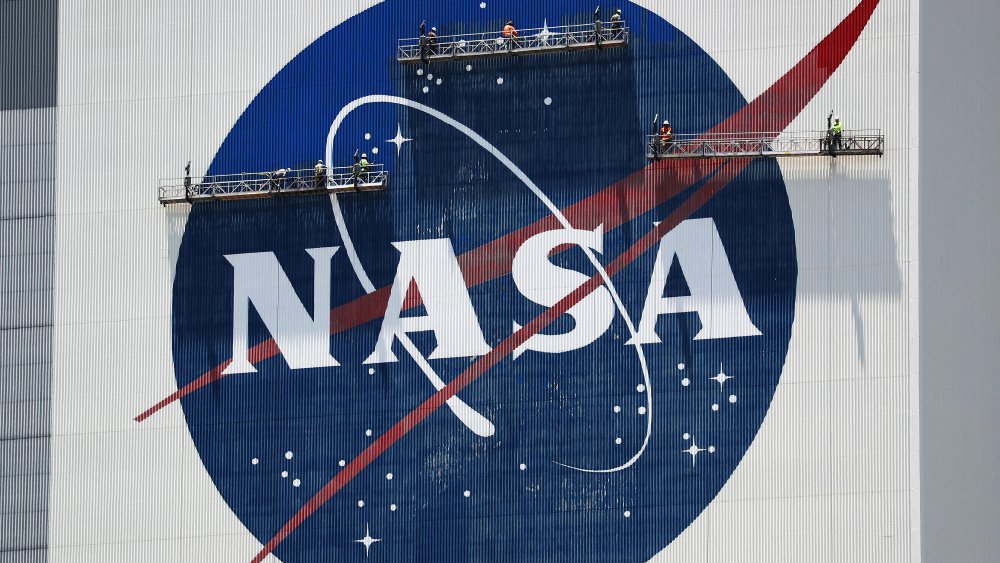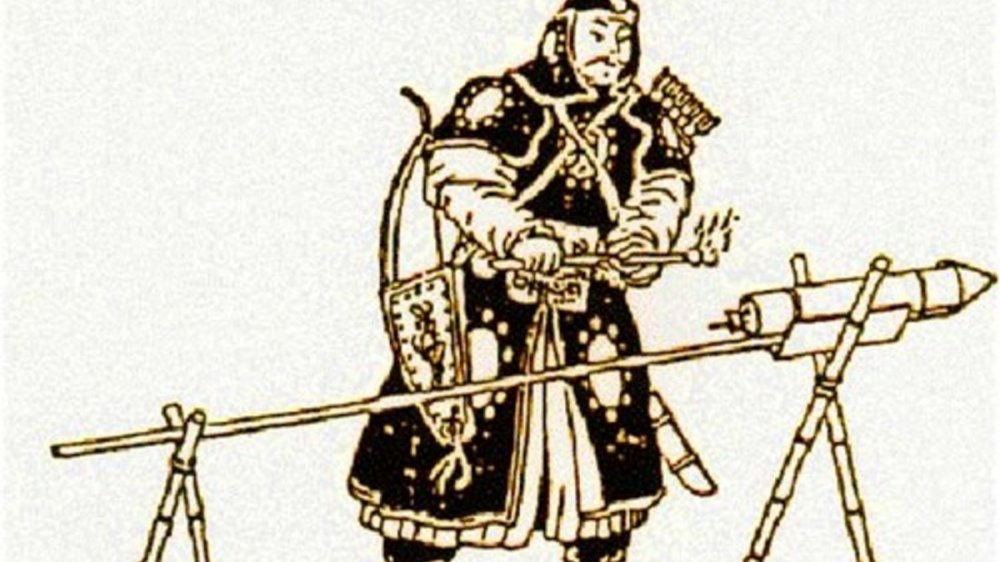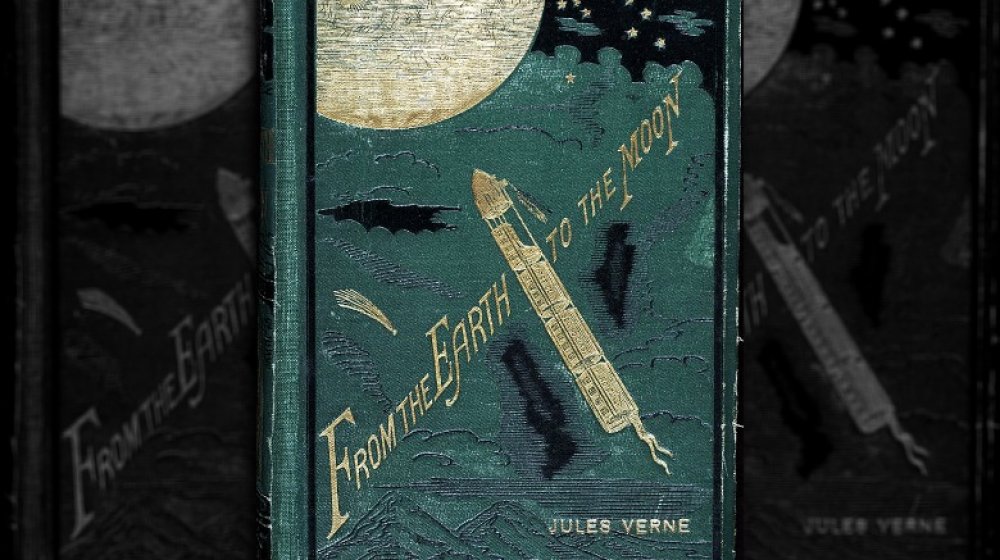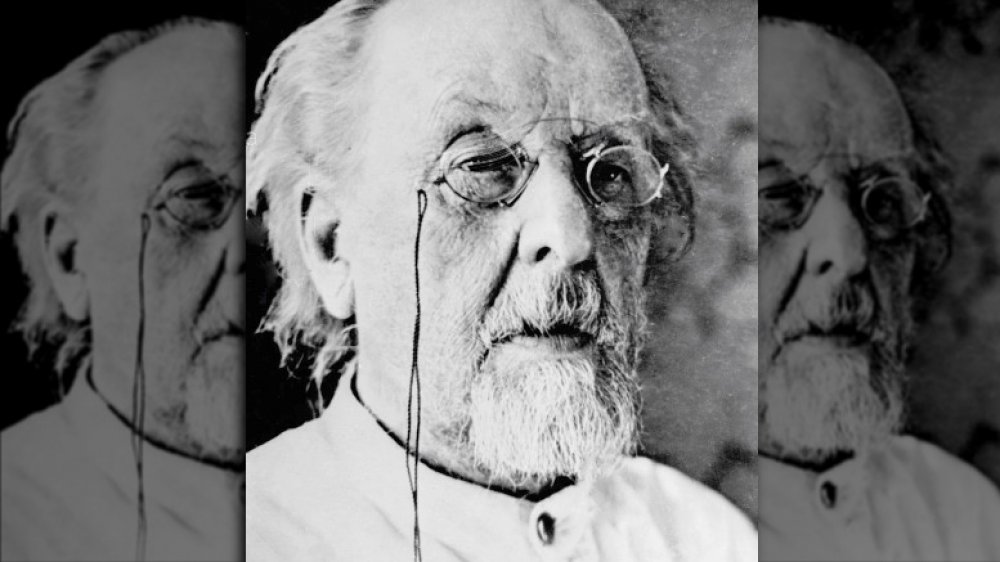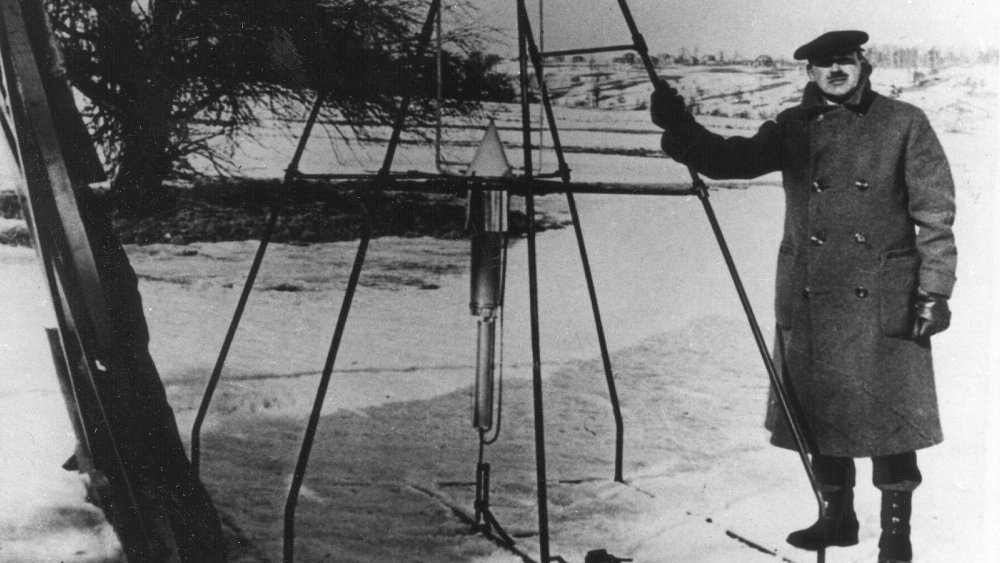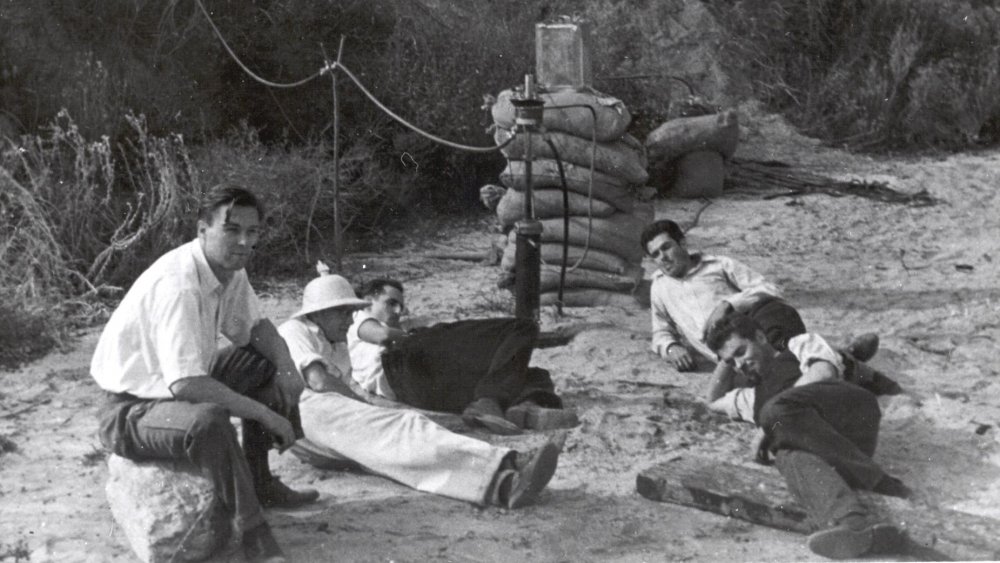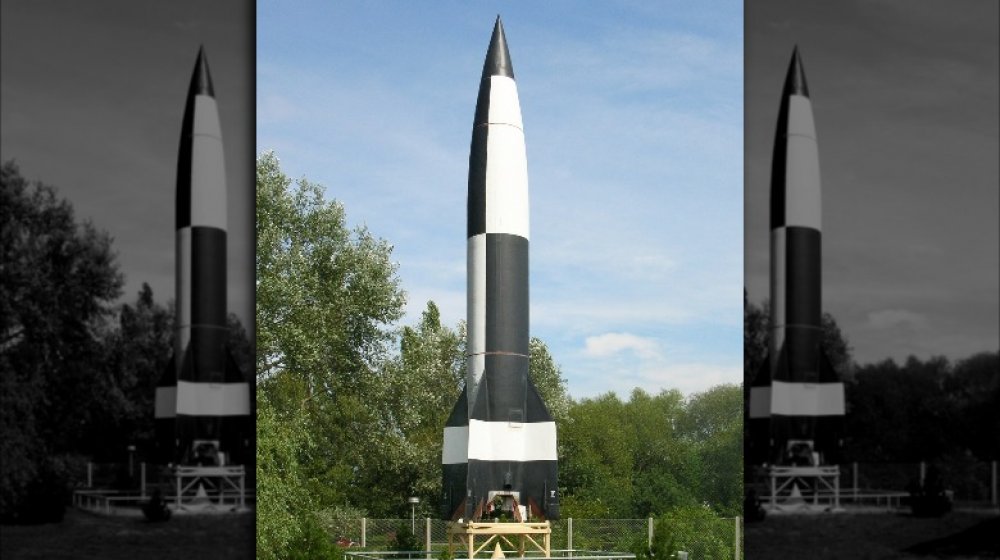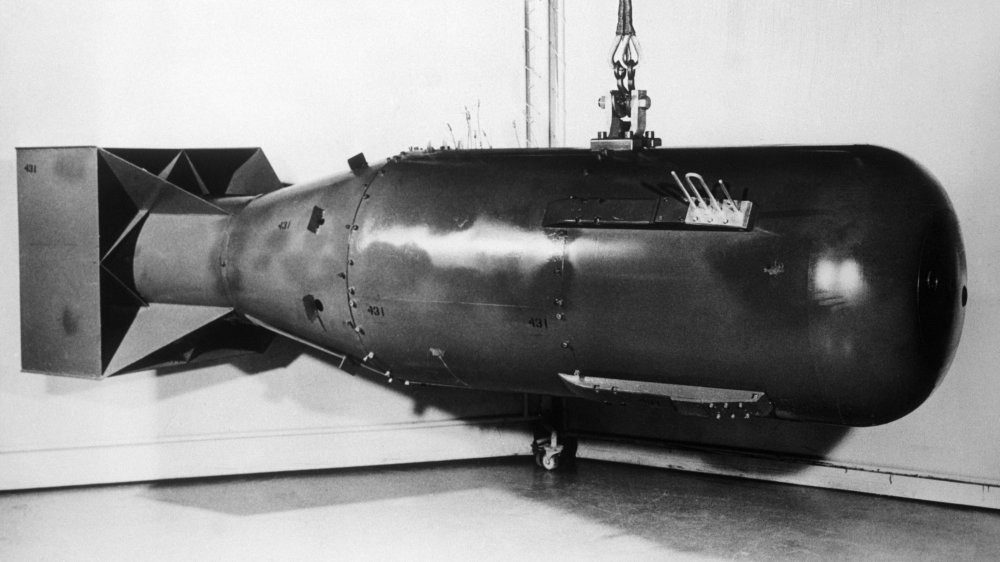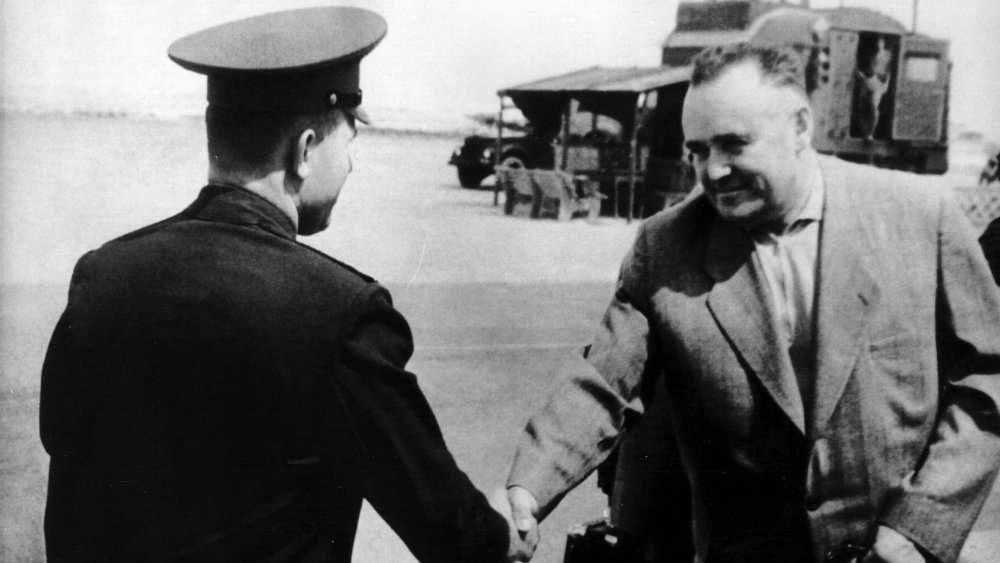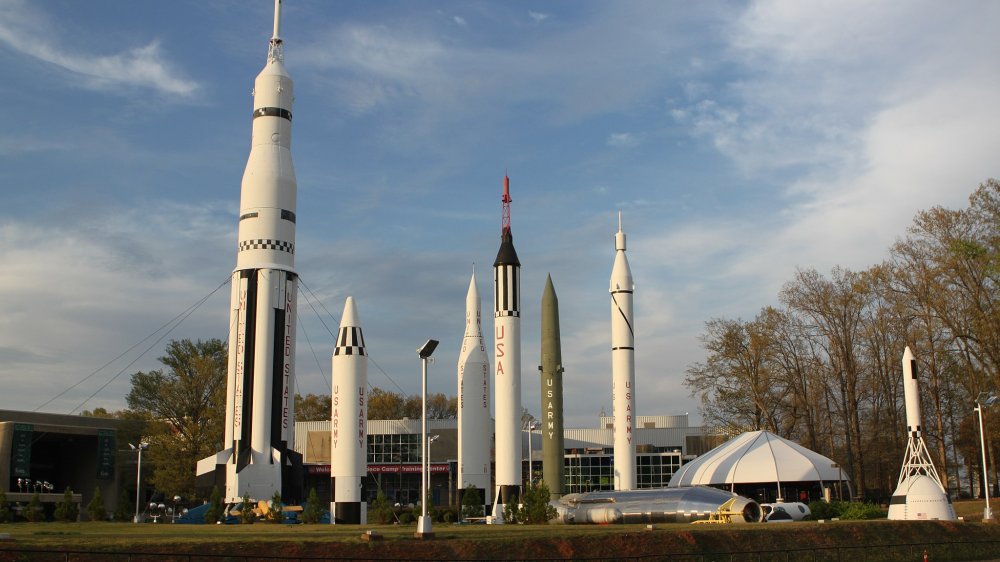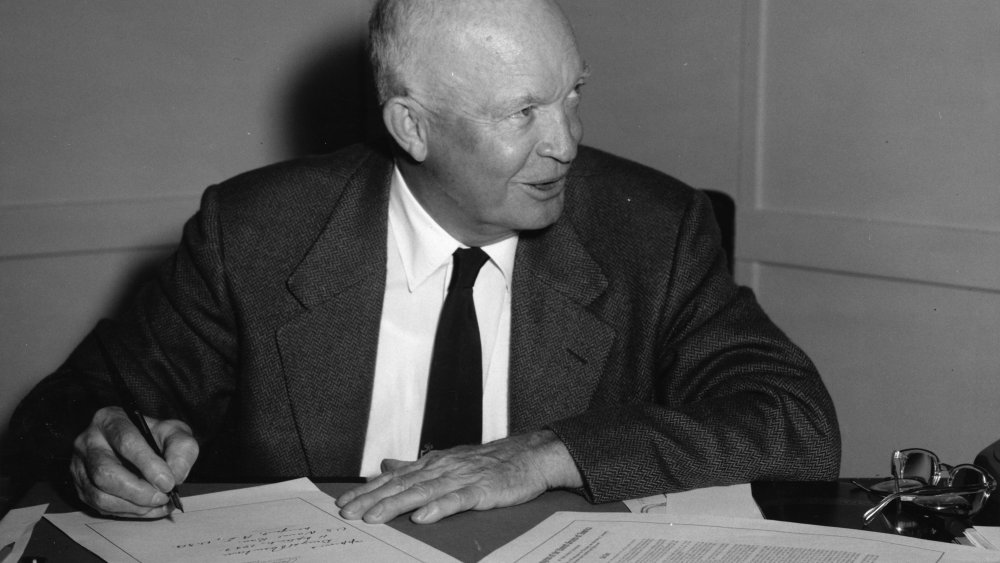The Events That Led Up To The Creation Of NASA
These days, NASA's logo can be found everywhere — from T-shirts to lunchboxes to even baby bibs. The iconic red, white, and blue insignia is ubiquitous, but even so, most Americans would probably struggle to recall what the logo's four letters actually stand for. Seriously, try to remember right now. Perhaps you're thinking "The National Air and, uh, Space Agency?" That would be close — but it's actually the National Aeronautics and Space Administration.
If we don't even know what "NASA" means, odds are that most of us have a very limited understanding of the administration's history. Sure, you might know that NASA sent the first men to the Moon in 1969. But how much do you know about the events that caused NASA to be created in the first place?
If you're struggling to think of anything, never fear — this article will walk you through the fascinating history of the world's competing rocket programs, from 13th-century China to 1950s America.
Rockets are developed in China in the 13th century
The story of NASA cannot be told without the story of rocketry. It's believed that the earliest rockets were developed in China, although the exact circumstances surrounding their development are unknown. According to NASA's Glenn Research Center, the Chinese had already developed a simple form of gunpowder — made out of saltpeter, sulfur, and charcoal dust — as early as the first century AD. This substance was mainly used for religious festivals, since gunpowder-packed tubes produced spectacular explosions. But, at some point, it was realized that these same tubes would fly forward if you left a small hole at one end. The military applications of this discovery were immediately clear, and the Chinese began strapping the tubes to arrows in order to propel them to great distances.
The first recorded use of these "fire-arrows" was in 1232, when Chinese military forces used them to fight off Mongol invaders at the battle of Kai-Keng. Fire-arrows were not known for their accuracy — there was no way to steer them once they were launched, of course — but, even so, their powerful thrust and range certainly made them a terrifying sight to behold. These gunpowder-propelled arrows are generally considered the first true rockets in human history. Their use would quickly spread to other regions, from the Middle East to Europe. Ironically, the spread of these rockets may have been driven by the Mongol Empire, which had also produced the weapon's first victims.
Jules Verne and H.G. Wells popularize space travel in their novels
For most of their history, rockets remained a purely military technology — the idea of using them as a means to travel into space wouldn't emerge until the beginning of the 20th century. While 20th-century scientists deserve the credit for turning rockets into spacefaring technology, the ideological inspiration for human spaceflight actually came from the science fiction authors of the 1800s.
Human cultures have long dreamed of space travel, but it wasn't until the rapid technological development of the industrial revolution that spaceflight became a real possibility. One of the first people to realize this was French author Jules Verne. His 1865 novel From the Earth to the Moon provides a detailed description of a hypothetical trip to the lunar surface. Verne's story was extremely prescient: The first people to reach the Moon are Americans (check) launching from Florida (yup), and they land safely in the ocean upon their return (correct). Following Verne's lead, British author H.G. Wells also helped to popularize spaceflight. His influential 1897 story War of the Worlds centers around a Martian invasion of Earth.
Interestingly, even these brilliant authors didn't predict that rockets would be what ultimately brought humans into space: In both stories, interplanetary travel is carried out by massive guns that fire manned projectiles into space. Nevertheless, both authors served as major inspirations to the curious minds of the early 20th century, two of whom were particularly central to the origins of NASA: Konstantin Tsiolkovsky and Robert Goddard.
Konstantin Tsiolkovsky publishes an important essay
Konstantin Tsiolkovsky was perhaps the first real "rocket scientist" in the world. Born in 1857, Tsiolkovsky was fascinated by the idea of spaceflight from a young age. According to The New York Times, he was particularly inspired by the writings of Jules Verne. But besides Verne, another of Tsiolkovsky's inspirations was the Russian spiritual tradition of "cosmism," an ideology that developed in the 19th century and asserted that space travel was the key to perfecting the human species. Tsiolkovsky came to believe that, by colonizing outer space, humans could usher in an era of complete peace and prosperity.
Like many space enthusiasts, Konstantin Tsiolkovsky wrote science fiction. But unlike the sci-fi authors who came before him, he also had the scientific knowledge to help make spaceflight a reality. His scientific research centered around aerodynamics, gas combustion, and a variety of other topics central to making rockets successfully fly into space. And, in 1903, he published the essay "The Exploration of Cosmic Space by Means of Reaction Devices," which Space.com describes as the first serious scientific work about the possibility of using rockets for space travel. In fact, the key equation Tsiolkovsky laid out in this paper formed the basis of modern rocket science and is now named after him.
Tsiolkovksy was instrumental to the development of rocket science as a legitimate academic field. In particular, he helped develop Russia — later the Soviet Union — into a powerhouse of rocketry.
Robert Goddard develops the first liquid-fueled rockets
Equally important to the development of modern rocketry was American scientist Robert Goddard. While Tsiolkovsky counts Jules Verne among his inspirations, Goddard was inspired by H.G. Wells' War of the Worlds. On October 19, 1899, 17-year-old Goddard climbed a cherry tree and later recalled feeling a sense of wonder when he stared at the sky above. By the time he climbed back down the tree, he was committed to studying how to get mankind into space. "Existence at last seemed very purposive," Goddard explained.
Goddard's most meaningful contribution to the field of rocket science comes from his study into liquid-fueled rockets — the kind that would ultimately bring humans to the Moon. According to Space Center Houston, pre-20th century rockets had relied on solid fuels like gunpowder, but Goddard was among the first to realize that liquid fuels could produce far greater acceleration. So, after many years of research and experimentation, Goddard was able to produce the first successful (yet simple) liquid-fueled rocket in 1926.
According to Encyclopedia Britannica, Robert Goddard spent the rest of his life studying rocketry, primarily operating out of a lab in Roswell, New Mexico. He also briefly offered his services to the military during World War II. Goddard died in 1945, over a decade before NASA was founded. Nevertheless, NASA's first flight complex is named after Goddard, and he is commonly remembered as the father of America's rocket program.
The Jet Propulsion Laboratory is formed at Caltech
After hearing about Robert Goddard's experiments with liquid-fueled rockets, many young American engineers became fascinated by the burgeoning field of rocket science. In particular, the California Institute of Technology was a hotbed for early rocketry. For his graduate thesis, a student named Frank Malina ran a series of experiments with alcohol-fueled rockets, accompanied by his colleagues Qian Xuesen (a.k.a. Tsien Hsue-Shen), Jack Parsons, and some others. Little did these young men know that their partnership would soon develop into a widely successful research institute: the Jet Propulsion Laboratory, or JPL.
Formed at the end of the 1930s, JPL was one of the earliest organized bodies for the study of rocket science in the U.S. It began as an entity within Caltech but became sponsored by the U.S. Army starting in the early 1940s. After that, JPL explains, its research centered around developing early ballistic missile systems. In 1958, JPL built America's first successful satellite, Explorer 1. When NASA was formed later that year, the entirety of JPL was brought under NASA control, and JPL remains a key part of NASA's organizational structure today.
Unfortunately, the founders of JPL did not live happily ever after. Jack Parsons died in a home laboratory explosion at the age of 37. Frank Malina was blacklisted in the U.S. after an FBI investigation revealed his communist affiliations. And Qian Xuesen would spend five years under house arrest as part of the "Red Scare" of the 1950s. Communist sympathizers had no place in America's rocket program. Nazis, on the other hand, were welcomed with open arms.
Nazi scientists develop the V-2 rocket
The most well-established rocket program of the early 20th century wasn't located in America or Russia but rather in Nazi Germany. The German military knew that rockets had obvious potential as weapons of war, so they dedicated a great deal of research toward their development.
German rocket science was begun by Hermann Oberth, but during the Nazi era, the star of the rocket program was a young man named Werner von Braun. Working for the military, von Braun developed the 20th century's most successful early rocket, the "Vergeltungswaffen-2," or V-2. The Germans used the V-2 rocket to launch a number of bombing campaigns against Allied territories, especially Belgium and the United Kingdom. V-2 rockets were not accurate enough to hit specific targets but could inflict major damage and casualties when fired at densely populated urban areas. According to the BBC, it's estimated that thousands of people were killed by German V-2 rockets during World War II, including over 2,700 in Great Britain alone.
No other rocket program was as successful as Germany's at that time — especially when "success" was measured in dead bodies. So, when Germany finally fell to Allied forces, the governments of both the United States and the Soviet Union scrambled to get Nazi rocket scientists to work for their respective rocket programs. The United States was more successful. According to History.com, America drew in roughly 1,600 German scientists by promising to overlook their war crimes. Werner von Braun would go on to work for NASA, designing the Saturn V rocket that got the first Americans to the Moon.
The U.S. needs a way to deliver the atomic bomb
In the final years of World War II, the American government funneled massive amounts of money into the "Manhattan Project" — the initiative to develop the first atomic weapons. The project was successful, and atom bombs were dropped on Hiroshima and Nagasaki in August 1945, killing around 200,000 people.
At first, this might not seem relevant to the creation of NASA, but, in fact, the development of atomic weaponry was central to the need for better rockets. The Los Alamos National Laboratory explains that atomic bombs — particularly the hydrogen bombs that were developed in the 1950s — were so heavy that few conventional planes could fly with them. Additionally, a slow-moving plane could easily be detected and shot down by an enemy before being able to deliver its payload. So, military officials realized that, for atomic weapons to reach their full destructive potential, they ought to be launched on missiles (guided rockets, that is). Well-designed missiles could reach basically anywhere in the world and would move so fast that the odds of the enemy successfully intercepting them would be very slim.
This military "need" for rocket delivery systems became much more urgent when the Soviet Union developed their own nuclear weapons in 1949. So, while NASA would be founded as a civilian research organization in 1958 — not a branch of the military — the U.S. government was certainly aware that any rocket research NASA produced could prove highly useful for military purposes as well.
Sergei Korolev is made the leader of the Soviet space program
Just as Jules Verne inspired Konstantin Tsiolkovsky, Tsiolkovsky himself was an inspiration to Sergei Korolev, the man who would lead the Soviet space program in the 1950s and '60s. Korolev was born in 1907 and spent his early career designing aircraft. In 1938, he was arrested under false charges of counterrevolutionary activities and spent several years in a labor camp. But Korolev didn't seem to hold a grudge against the state and agreed to help run the Soviet Union's early missile program in the 1940s. Soon after, according to Space.com, Korolev's role essentially evolved to "head of the Soviet space program" — but the exact details remain secret.
Under Korolev's leadership, the Soviet space program had a number of noteworthy successes. Korolev was the chief designer for the R-7 family of rockets, including the R-7 Semyorka, an intercontinental ballistic missile. He also oversaw a number of successful animal test flights in the 1950s: Over a dozen dogs were loaded onto rockets, launched to the edge of space, and brought to a safe landing. (The U.S. also carried out animal flights during this period, but most of the test monkeys died in the process.) Later, in 1957, Korolev would preside over the Soviet Union's crowning achievement: the launch of the first successful satellite, Sputnik 1.
Unfortunately, Sergei Korolev was highly secretive with his research, so his death in 1966 was a major setback for the Soviet space program. Korolev's dream — landing Soviet astronauts on the Moon — would never become a reality.
The U.S. Army, Navy, and Air Force compete to develop rockets
The U.S. military was keenly aware of the Soviet Union's progress in the realm of space. But rather than forming a partnership to defeat the Soviets, the late 1950s saw massive competition in rocket development between the Air Force, Army, and Navy.
Surprisingly, some of the earliest rocket successes came from the Army. The Army's Redstone rocket line – and the Juno line that emerged from it — were America's first successful missiles: They were designed by a team led by Werner von Braun. In a proud moment for the Army, a Juno rocket launched America's first satellite, Explorer 1, in 1958. The Navy was less successful in the space arena: Its Vanguard rocket was supposed to launch the first American satellite but blew up on the launchpad in 1957. (Still, Vanguard rockets would carry out a number of successful missions in the following years.)
The Air Force had arguably the most success with space research, though. In the late 1950s, the Air Force began to develop the successful "Atlas" line of rockets, which would carry probes to the Moon. Besides developing rockets, the Air Force also conducted some of the first scientific studies into the effects of extremely high altitude on the human body. One initiative, "Project Man High," brought men to the edge of space in polyethylene balloons.
In the 1950s, America's lack of a centralized space program wasn't really viewed as a problem that needed to be addressed. Until...
The Soviet Union launches Sputnik
In the middle of the 1950s, both the United States and the Soviet Union agreed to participate in the "International Geophysical Year" — a global event from 1957 to 1958 emphasizing scientific interchange between all nations. As part of this event, the United States announced its intention to launch several small satellites. The Soviets were quick to follow suit, Popular Science explains.
For the most part, the American government was confident that it could beat the Soviets in this technological race. But terror struck on October 4, 1957, when news spread of the Soviet Union's successful launch of Sputnik 1, a small radio-equipped satellite. Frenzied American newspapers referred to Sputnik as an "artificial moon" and worried that the satellite could be spying on America's every move. Naturally, the American public was outraged and terrified: For all its wealth, military strength, and scientific prowess, how could the United States have possibly been beaten by the Soviet Union? Although Sputnik 1 was only the size of a volleyball, none of America's rockets were developed enough to launch anything into orbit at that time.
America's embarrassment was doubled when the Soviet Union launched another satellite, Sputnik 2, on November 3. This one even had an occupant: Laika, a stray dog from the streets of Moscow. The Soviets had now launched two successful satellites, while the United States had launched zero. This was unacceptable — something had to change.
President Eisenhower turns NACA into NASA
The launch of Sputnik was a major smack in the face to President Dwight D. Eisenhower. Public confidence in the Eisenhower administration waned significantly: Then-Senator Andrew Johnson even accused Eisenhower – a World War II general — of not granting enough resources to the military to adequately defend the country. With public pressure mounting, Eisenhower knew he had no choice. To preserve the country's image, he had to find a way to achieve American dominance in space.
So far, the military had not been up to the task. Infighting between branches remained a severe impediment to progress. As a result, Eisenhower's administration decided that America's space program should be run by a centralized civilian agency instead. At the time, the closest thing that fit this description was the National Advisory Committee for Aeronautics (NACA), a relatively small branch of the government dedicated to researching issues of flight.
So, on July 29, 1958, Eisenhower's signature formally rebranded NACA as the National Aeronautics and Space Administration, now ubiquitously referred to as NASA. NASA would operate as a new branch of the government: In the words of the Space Act of 1958, it would be granted an adequate budget for "the expansion of human knowledge of [...] space" and "the improvement of the usefulness, performance, speed, safety, and efficiency of [...] space vehicles."
And the rest, as they say, is history. NASA's accomplishments speak for themselves — from the Apollo moon landings to the Hubble Space Telescope.
